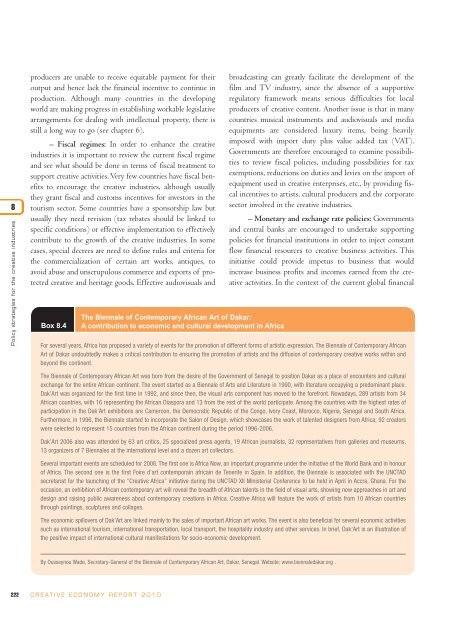Creative Economy: A Feasible Development Option
Creative Economy: A Feasible Development Option
Creative Economy: A Feasible Development Option
- No tags were found...
Create successful ePaper yourself
Turn your PDF publications into a flip-book with our unique Google optimized e-Paper software.
8Policy strategies for the creative industriesproducers are unable to receive equitable payment for theiroutput and hence lack the financial incentive to continue inproduction. Although many countries in the developingworld are making progress in establishing workable legislativearrangements for dealing with intellectual property, there isstill a long way to go (see chapter 6).– Fiscal regimes: In order to enhance the creativeindustries it is important to review the current fiscal regimeand see what should be done in terms of fiscal treatment tosupport creative activities. Very few countries have fiscal benefitsto encourage the creative industries, although usuallythey grant fiscal and customs incentives for investors in thetourism sector. Some countries have a sponsorship law butusually they need revision (tax rebates should be linked tospecific conditions) or effective implementation to effectivelycontribute to the growth of the creative industries. In somecases, special decrees are need to define rules and criteria forthe commercialization of certain art works, antiques, toavoid abuse and unscrupulous commerce and exports of protectedcreative and heritage goods. Effective audiovisuals andBox 8.4The Biennale of Contemporary African Art of Dakar:A contribution to economic and cultural development in Africabroadcasting can greatly facilitate the development of thefilm and TV industry, since the absence of a supportiveregulatory framework means serious difficulties for localproducers of creative content. Another issue is that in manycountries musical instruments and audiovisuals and mediaequipments are considered luxury items, being heavilyimposed with import duty plus value added tax (VAT).Governments are therefore encouraged to examine possibilitiesto review fiscal policies, including possibilities for taxexemptions, reductions on duties and levies on the import ofequipment used in creative enterprises, etc., by providing fiscalincentives to artists, cultural producers and the corporatesector involved in the creative industries.– Monetary and exchange rate policies: Governmentsand central banks are encouraged to undertake supportingpolicies for financial institutions in order to inject constantflow financial resources to creative business activities. Thisinitiative could provide impetus to business that wouldincrease business profits and incomes earned from the creativeactivities. In the context of the current global financialFor several years, Africa has proposed a variety of events for the promotion of different forms of artistic expression. The Biennale of Contemporary AfricanArt of Dakar undoubtedly makes a critical contribution to ensuring the promotion of artists and the diffusion of contemporary creative works within andbeyond the continent.The Biennale of Contemporary African Art was born from the desire of the Government of Senegal to position Dakar as a place of encounters and culturalexchange for the entire African continent. The event started as a Biennale of Arts and Literature in 1990, with literature occupying a predominant place.Dak’Art was organized for the first time in 1992, and since then, the visual arts component has moved to the forefront. Nowadays, 289 artists from 34African countries, with 16 representing the African Diaspora and 13 from the rest of the world participate. Among the countries with the highest rates ofparticipation in the Dak’Art exhibitions are Cameroon, the Democratic Republic of the Congo, Ivory Coast, Morocco, Nigeria, Senegal and South Africa.Furthermore, in 1996, the Biennale started to incorporate the Salon of Design, which showcases the work of talented designers from Africa; 92 creatorswere selected to represent 15 countries from the African continent during the period 1996-2006.Dak’Art 2006 also was attended by 63 art critics, 25 specialized press agents, 19 African journalists, 32 representatives from galleries and museums,13 organizers of 7 Biennales at the international level and a dozen art collectors.Several important events are scheduled for 2008. The first one is Africa Now, an important programme under the initiative of the World Bank and in honourof Africa. The second one is the first Foire d’art contemporain africain de Tenerife in Spain. In addition, the Biennale is associated with the UNCTADsecretariat for the launching of the “<strong>Creative</strong> Africa” initiative during the UNCTAD XII Ministerial Conference to be held in April in Accra, Ghana. For theoccasion, an exhibition of African contemporary art will reveal the breadth of African talents in the field of visual arts, showing new approaches in art anddesign and raising public awareness about contemporary creations in Africa. <strong>Creative</strong> Africa will feature the work of artists from 10 African countriesthrough paintings, sculptures and collages.The economic spillovers of Dak’Art are linked mainly to the sales of important African art works. The event is also beneficial for several economic activitiessuch as international tourism, international transportation, local transport, the hospitality industry and other services. In brief, Dak’Art is an illustration ofthe positive impact of international cultural manifestations for socio-economic development.By Ousseynou Wade, Secretary-General of the Biennale of Contemporary African Art, Dakar, Senegal. Website: www.biennaledakar.org .222 CREATIVE ECONOMY REPORT 2010
















